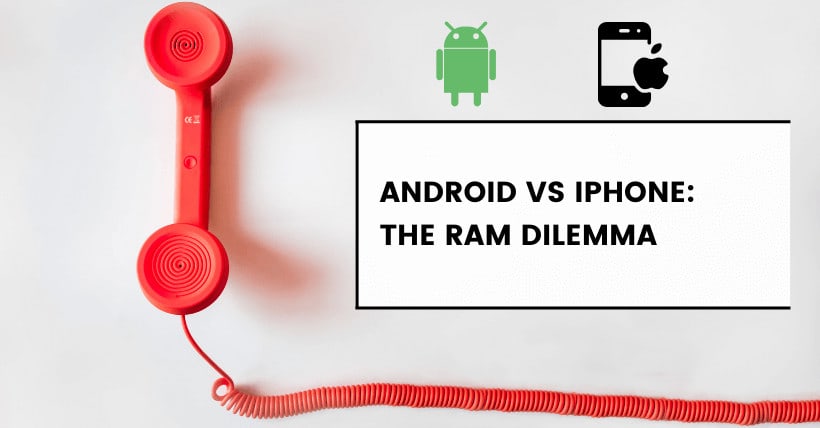1. Why Android phones boast 32GB of RAM while iPhones settle for 6GB
In the ever-evolving world of smartphones, the race for superiority isn’t just about camera quality or design aesthetics; it’s about how these devices perform. A significant component that impacts a smartphone’s performance is RAM (Random Access Memory). If you’ve ever wondered why Android phones now sport a whopping 32GB of RAM while iPhones are content with just 6GB, you’re not alone. Let’s unravel this technological mystery.
2. The Role of RAM in Smartphone Performance
First, let’s clarify the role of RAM in a smartphone’s performance. In a nutshell, RAM provides temporary cache space for running apps. The more RAM a phone has, the more efficiently it can handle multiple applications simultaneously. It’s like having a bigger workspace to juggle tasks, making your phone run smoother.
3. Apple’s RAM vs. Android’s RAM
In theory, a higher RAM capacity should lead to better performance. However, this theory doesn’t entirely apply to Apple devices. Since the inception of the iPhone, Apple has consistently maintained a lower RAM capacity compared to Android phones. While mainstream Android devices have skyrocketed to 12GB, 16GB, and even 24GB of RAM, Apple seems content with just 6 GB. But here’s the intriguing part – Apple’s devices remain incredibly smooth and performant, even with this seemingly meager 6GB.
So, what’s the problem?
4. Memory Mechanism: Apple vs Android
The primary factor contributing to this discrepancy lies in the memory mechanism employed by Apple’s iOS and Android operating systems. Android is an open-source system, which allows extensive modifications and adjustments, even at the low-level system. This open nature is a playground for software developers, who are eager to create feature-rich apps that consume a significant amount of memory.
Apple, on the other hand, operates a closed system with a foreground-first memory mechanism. In simpler terms, it allocates all memory resources to the currently active app, terminating background apps. This ensures a smooth experience, even with just 6GB of RAM. The stringent approval process in the iOS App Store further guarantees that apps meet memory requirements, preventing resource-hungry apps from clogging up your device.
5. Android’s Memory Challenges
In contrast, Android’s open nature and lenient permission management allow apps to consume more memory. System updates alone can consume a substantial portion of RAM, irrespective of the available capacity. Android is also less aggressive in terminating background apps, which naturally leads to a greater need for memory. As the Android ecosystem has grown, apps and games have become more resource-intensive, further increasing the demand for memory capacity.
6. The Way Forward
For Android devices, it might be time to consider stringent permission management and memory mechanism refinement. Setting memory thresholds for apps, akin to iOS, can be a step in the right direction. After all, even 64GB of RAM won’t make a difference if it’s not used efficiently.
So, why does your Android phone flaunt 32GB of RAM while your friend’s iPhone manages perfectly fine with just 6GB? It’s all about how they manage and utilize their memory.
7. Conclusion
In the ever-evolving tech landscape, the disparity in RAM between Android and iPhone is a result of their distinct memory mechanisms and ecosystem philosophies. While Android revels in the open-source freedom that lets apps consume more memory, Apple’s strict control over memory allocation ensures a smooth experience with less RAM. Both approaches have their merits, but the grass isn’t necessarily greener on the other side.
Now, let’s answer some common questions about this RAM divide.
8. FAQs About Android and iPhone RAM Differences
Q1. Why do Android phones have so much RAM?
Android phones require more RAM due to their open-source nature and the need for efficient memory management. As the Android ecosystem grows, memory demands increase.
Q2. How does Apple manage with less RAM?
Apple’s iOS employs a foreground-first memory mechanism, allocating all available memory to the active app while terminating background apps, ensuring a smooth experience.
Q3. Are more gigabytes of RAM always better?
Not necessarily. The efficiency of RAM utilization matters as much as the capacity. A well-optimized system with less RAM can outperform one with more RAM but poor management.
Q4. Can Android phones benefit from Apple’s memory management approach?
Android could improve memory management by adopting a more stringent approach to app permissions and memory usage, similar to Apple’s iOS.
Q5. Will the RAM divide between Android and iPhone ever change?
It’s uncertain. Both ecosystems have their strengths and weaknesses. The RAM divide may persist as long as they uphold their respective philosophies.
Related:

Disclaimer:
- This channel does not make any representations or warranties regarding the availability, accuracy, timeliness, effectiveness, or completeness of any information posted. It hereby disclaims any liability or consequences arising from the use of the information.
- This channel is non-commercial and non-profit. The re-posted content does not signify endorsement of its views or responsibility for its authenticity. It does not intend to constitute any other guidance. This channel is not liable for any inaccuracies or errors in the re-posted or published information, directly or indirectly.
- Some data, materials, text, images, etc., used in this channel are sourced from the internet, and all reposts are duly credited to their sources. If you discover any work that infringes on your intellectual property rights or personal legal interests, please contact us, and we will promptly modify or remove it.



